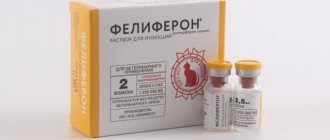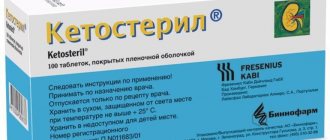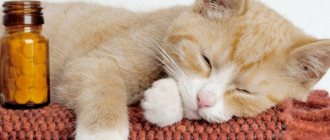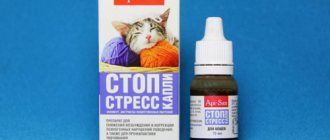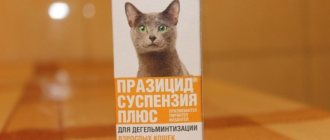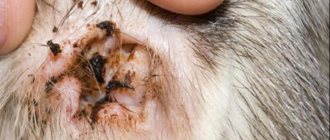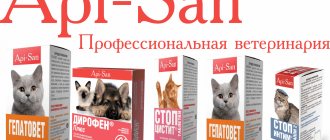Acylok is a drug that restores normal secretion of gastric juice. Blocks histamine receptors. Reduces the production of stimulated and basal hydrochloric acid, which neutralizes its effect on the mucous surfaces of the gastrointestinal tract. Acylok - helps restore tone in the lower esophageal sphincter.
Acylok is used as part of complex treatment of dogs. The drug is prescribed when other medicinal substances have not given positive results. Acyloc is also used as an antiemetic and to prevent the reflux of food from the stomach into the esophagus.
Irreversible processes can occur hidden, but the entire body will suffer. Early detection of pathology will help the owner reduce the likelihood of a dangerous course of the disease to a minimum.
How to identify pathology
- Changes in the animal's feeding behavior.
- Decreased appetite.
- Change in body temperature (normal from 38.5 to 39 degrees)
- Decreased pet activity.
- In severe cases of the disease - vomiting, diarrhea.
This may be a manifestation of a stomach or intestinal ulcer, gastritis, gastroenterocolitis, gastroenteritis, reflux - esophagitis. In dogs, pathological processes cover the entire digestive system - the esophagus, stomach, and intestines at the same time.
pharmachologic effect
Acylok is an Indian-made medicine that is used not only in veterinary medicine. First of all, the drug is intended for the treatment of people suffering from pathologies of the stomach and intestines, and it can be purchased at any pharmacy. The medicine is also successfully used in animals diagnosed with: exacerbation of gastric and duodenal ulcers; symptomatic ulcers; reflux esophagitis (inflammation of the esophageal mucosa); gastritis; pathology of the pancreas; diseases of the kidneys and urinary system. The drug is absorbed in a short time, reaching maximum concentration in the body after about 2 hours. The medicine reduces the secretion of hydrochloric acid and reduces the amount of gastric juice, facilitating the digestion process. It acts for 12 hours and is excreted from the body along with urine and feces. According to reviews from pet owners, thanks to Acyloc, cats get rid of nausea and vomiting and develop a healthy appetite. In addition, during exacerbation of a stomach ulcer, the drug smoothes out its symptoms.
Release form
- Solution for intravenous, intramuscular and subcutaneous injection. In ampoules of 2 mil. Working solution 25 mg/ml. Blister packaging, cells of 5 ampoules.
- Tablet form of 150 and 300 mg, in blister-type packaging of 10 pcs.
Treatment of ulcers in the gastrointestinal tract - taking the drug does not depend on feeding. For treatment in the acute phase, 150 mg twice a day. For large breeds, 300 mg twice daily. Treatment is prolonged up to 4 - 6 weeks.
Treatment of Solinger-Ellison syndrome: 150 mg three times a day. In the treatment of Reflux - Esophagitis, 300 mg once a day. Mendelssohn's syndrome: 150 mg one day before anesthesia and 150 mg two hours before anesthesia.
Dosage of acyloc in ampoules for dogs
- Weight 1 kg - 0.12 ml 2 times a day
- Weight 3.125 kg - drug dose in 0.25 ml ampoules
- Dog weight 6.25 kg - dose of the drug "Acylok" 0.5 ml
- The dog's weight is 12.5 kg - the dose of acyloc is 1 ml IM, IV drip, s.c.
- Dog weight 25 kg - acyloc dose 2 ml (1 ampoule) every 12 hours
- Dog weight 50 kg - acyloc dose 4 ml (2 ampoules) 2 times a day
This article serves as an archival resource only and should not be considered current medical advice.
The usual dosage of acyloc for dogs is 0.25 to 1 mg per pound every 8 to 12 hours. Acyloc can be used orally or in injection form.
It is available in regular tablets or dissolvable tablets, which usually come in 75 mg, 150 mg or 300 mg strengths. Your veterinarian can further instruct you on how to use the correct dosage for your dog.
Your dog should take the medication without food because food makes it less effective. You should continue the medication regimen prescribed by your veterinarian, even if symptoms improve, until your veterinarian tells you to stop.
Your veterinarian may change the dosage depending on your dog's response to the drug or the specific condition they are treating.
Side effects
- Digestive system, if the dosage is incorrect - vomiting, diarrhea
- Hematopoietic organs, if the dosage is exceeded - thrombocytopeia, agranulosis, pancytopeia
- Nervous system, decreased muscle tone, involuntary contraction of skeletal muscles, convulsions.
- Endocrine system, when treating pregnant and lactating animals, gynecomastia and hyperprolacthymia are possible.
Self-treatment of a dog with the drug is excluded . The drug can hide the picture of diseases such as stomach carcinoma, cancer and ulcers. In addition, after prolonged treatment, a veterinarian consultation and re-diagnosis of the dog are required.
The drug, like all pharmacological substances, histamine blockers, can cause “rebound” syndrome at the end of treatment.” A specialist will help you remove the unwanted effect of stopping the medication. It is necessary to take into account that with long-term treatment of weakened and old animals, bacterial infections of the gastrointestinal tract are possible. This may cause the presence of protein in the animal's urine test.
If an animal is diagnosed with renal dysfunction, then the recommended dose should be reduced to 50 ml in solution and 150 mg in tablets per day.
After treatment, the dog needs a special diet that does not contain mono and disaccharides, lactose, and gluten. This diet will reduce fermentation processes in the dog’s intestines. There is a special dietary food, the fat content of which is significantly lower than normal, it is well absorbed by the dog’s gastrointestinal tract.
Directions for use and dosage for cats
The solution is administered by intramuscular injection. The dosage is determined based on the weight of the animal; 0.1 ml of solution is used per 1 kg of body weight. Injections are given twice a day for a week. The duration of treatment is determined by the veterinarian based on the condition of the cat.
Acylok in ampoules: instructions for use for cats
Gamavit for cats: dosage and instructions for use
It is recommended to inject the solution into the hamstring muscle or into the pad of the hind llama. At home, it is better to use an insulin syringe; it has a shorter needle and is easier for an inexperienced person to handle. The needle must be inserted at a right angle approximately 1 cm deep. You must be careful and try not to damage the nerve.
Note! The liquid is administered slowly; pressing the plunger of the syringe quickly will cause pain to the pet.
To administer the injection, it is better to buy insulin syringes
Instructions for Aciloka for cats in tablet form
The tablets can be taken if there is no vomiting. The maximum duration of treatment is 20 days. The tablet can be given whole, placed on the root of the tongue. Pharmacies also sell special syringes for pills, with their help it is easy to force the cat to swallow the medicine. Or you can crush and dissolve the tablet in water and pour it into the throat with a syringe without a needle.
Contraindications and side effects
Inspector drops for cats: instructions for use
The drug has proven itself well; cats can easily tolerate taking this medication. But treatment of cats weighing up to 1.5 kg, as well as pregnant females, is prohibited. Cats nursing a litter should also be restricted from treatment with this drug.
Important! If the animal is severely weakened or is elderly, a hypersensitivity reaction is possible. To eliminate this condition, antiallergic drugs are taken.
Contraindications for use also include malignant formations of the esophagus, individual intolerance to the drug substance, and acute liver disease. Overdose may contribute to side effects.
Side effects of Acyloc can be:
- the appearance of seizures;
- nausea and vomiting;
- weakness, decreased activity;
- heart rhythm disturbance;
- dry mouth;
- bowel dysfunction;
- headache;
- hair loss.
The drug should be taken according to the instructions, otherwise there is a risk of side effects.
special instructions
Before prescribing the drug, it is recommended to examine the animal for the absence of diseases of malignant formations of the esophagus, stomach, and duodenum. With prolonged use in a weak animal under stress, bacterial damage to the stomach sometimes occurs with the spread of infection.
Advantage for cats: instructions for use
If the pet is normal, then while taking the medicine it is necessary to adjust the diet, make it more dietary, and eliminate excessive consumption of fatty foods and those containing lactose.
For individuals with liver and kidney diseases, the standard dosage is reduced by 50 ml for solution and to 150 ml when using tablets. If the functioning of these organs is disrupted, the owner must consult a veterinarian.
Note! There is a compensation effect - an increase in the symptoms of the disease when the course of treatment is abruptly stopped. It is best to stop treatment several days in advance, gradually reducing the dosage and number of injections.
Interaction with other drugs
If medications such as sucralfates and antacids are taken simultaneously with Acyloc, then it is necessary to take a break between doses. About two hours is enough for the medicine to completely dissolve and the active phase of its action to end, after which Acylok is taken.
Application
Acylok in ampoules is recommended for use in case of vomiting in a cat in the form of injections twice a day for five days as one of the means of complex therapy. The course of treatment with the drug must be prescribed by a veterinarian. As a rule, when you go to a veterinary clinic with complaints of nausea and vomiting in a cat, first of all they will give you an Aciloc injection.
The dose for intramuscular administration of the drug Acylok to a cat is easy to calculate - for one kilogram of the pet’s body weight you will need to take 0.1 ml of the drug. The injection must be done intramuscularly with an insulin syringe into the tissue of the hind paw. Administration of Acyloc in the form of an injection solution is a non-painful procedure for the animal.
When vomiting, you should not give the drug in the form of tablets to a cat, as this is useless - everything will come out along with the vomit.
Cancellation of Aciloc should be gradual, otherwise unpleasant effects are possible. As a rule, cats tolerate treatment with the drug well and side effects are rare. It is not recommended to give injections longer than seven days, as this will cause painful injections, muscle damage and damage to the pet’s skin.
If the cat is not vomiting, then you can give it tablets. In this case, the drug will be taken for a long time - for approximately three weeks. For severe vomiting, intravenous and then intramuscular administration of drugs is recommended. Once the cat’s condition has stabilized, you can switch to oral forms.
An analogue of Aciloc is the drug Zantac. The price of a package with ten ampoules is approximately 210 rubles .
You cannot carry out a course of Acyloc therapy without a doctor’s prescription, since there are many nuances that need to be taken into account. For example, the health status of the animal, its body weight, the specific course of the disease.
Diseases of the gastrointestinal tract are typical not only for humans, but also for cats. Some animals have pathologies from birth, some become ill due to poor nutrition or other reasons. Acylok for cats allows you to effectively combat gastrointestinal problems; this medicine has earned the recognition of many veterinarians.
General precautions
Side effects associated with the proper use of Acyloc in animals are rare. Some animals may experience worsening of existing heart rhythm problems, and human patients may experience confusion and headaches.
Acylok is not intended for use in animals with kidney or liver disease. Although acyloc appears safe for use during pregnancy, it should be avoided in lactating animals. The drug may cause urine tests to be falsely positive for protein.
Acyloc in animals may interact with some other supplements and medications, including propranolol, theophylline, ketoconazole, itraconazole, and some antacids.
Acyloc should not be used in animals with a known allergy or hypersensitivity to the drug. Any known or suspected overdose should be reported to your veterinarian immediately.
Indications and contraindications
When using Acyloc, contraindications should be taken into account. Do not use the drug if the cat has hypersensitivity to at least one of its components.
Indications for use:
- as a remedy for a cat’s sore stomach;
- for duodenal and gastric ulcers (postoperative or symptomatic);
- with reflux esophagitis;
- as a means of preventing exacerbations of gastritis and gastric ulcers.
When using Acyloc, cats' appetite increases and nausea is eliminated.
